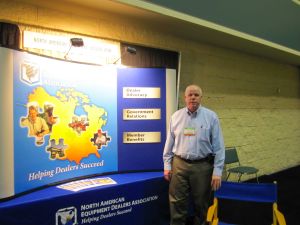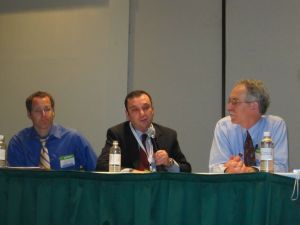There were several international manufacturing equipment associations on hand at the AG CONNECT Expo including the North American Equipment Dealers Association (NAEDA), one of the show sponsors. I sat down with Michael Williams, the Vice President of Government Relations, to learn more about what his association does. This 110 year-old association has more than 5,000 members in the U.S. as well as several affiliates in Canada. Since its inception, they have been providing its members manufacturing relations and government relations as well as member relations services including freight programs, telephone programs and credit card programs.
 During the show, NAEDA was approached by some of the international manufacturers to set up some dealer networks in the U.S. Williams said that there are two secenaries these manufacturers have. One is they have a patent pending and two an existing company wants a presence in the States. In order for NAEDA to help them, Williams said the patent must be approved first and then he needs to know if they are wanting to sell through a distributor or dealers. “We’re giving them suggestions about dealer agreements and tools that dealers need to take a new product international.”
During the show, NAEDA was approached by some of the international manufacturers to set up some dealer networks in the U.S. Williams said that there are two secenaries these manufacturers have. One is they have a patent pending and two an existing company wants a presence in the States. In order for NAEDA to help them, Williams said the patent must be approved first and then he needs to know if they are wanting to sell through a distributor or dealers. “We’re giving them suggestions about dealer agreements and tools that dealers need to take a new product international.”
In addition to these services, NAEDA also has a foundation that is almost as old as the association. The foundation is to aid members who have experienced a hardship like a hurricane or flood. They were very involved in Iowa last year during the flooding. “The best part of the foundation is that we’re very quick to react,”said Williams. A dealer in need can have a check in 48-60 hours.
To learn more about NAEDA visit their website.
Listen to my interview with Michael here.

 There were many tractors and loaders filling the McCormick booth during
There were many tractors and loaders filling the McCormick booth during  Many people came to McCormick’s booth to encourage them, along with other American-based companies, to invest more overseas in investment and education. While Miller agreed that this should happen, he also said that more international ag companies should consider investing in America’s agricultural industry.
Many people came to McCormick’s booth to encourage them, along with other American-based companies, to invest more overseas in investment and education. While Miller agreed that this should happen, he also said that more international ag companies should consider investing in America’s agricultural industry.
 For the sixth year in a row,
For the sixth year in a row,  high quality feed, consistency of feed and how well the corn cracked. The cross Jaquar delivers all that.”
high quality feed, consistency of feed and how well the corn cracked. The cross Jaquar delivers all that.” Valmont Industries took home two AE50 awards during the AG CONNECT Expo last week including one for its Base Station 2 with soil moisture monitor. Michele Stolte, with
Valmont Industries took home two AE50 awards during the AG CONNECT Expo last week including one for its Base Station 2 with soil moisture monitor. Michele Stolte, with  Dr. Tom Richard, Associate Professor with Pennsylvania State University, kicked off the session discussing the agricultural value of adding winter crops or double crops to a farmer’s rotation. An example of a winter crop that would be suitable for Pennsylvania is winter rye. Once harvested, the crop could be used for cellulosic ethanol. An example of a double crop would be planning a grain such as barley in the spring followed by a summer crop such as corn or soybean. Richard noted that when most people do a biomass potential study, they don’t factor in winter crops and double crops, thus reducing the amount of biofuels that could be produced on the same amount of land currently in production.
Dr. Tom Richard, Associate Professor with Pennsylvania State University, kicked off the session discussing the agricultural value of adding winter crops or double crops to a farmer’s rotation. An example of a winter crop that would be suitable for Pennsylvania is winter rye. Once harvested, the crop could be used for cellulosic ethanol. An example of a double crop would be planning a grain such as barley in the spring followed by a summer crop such as corn or soybean. Richard noted that when most people do a biomass potential study, they don’t factor in winter crops and double crops, thus reducing the amount of biofuels that could be produced on the same amount of land currently in production.
 It’s time for the
It’s time for the 